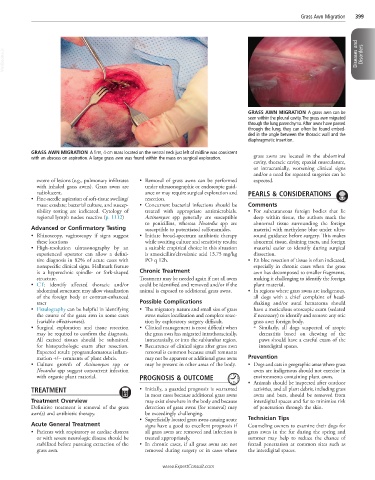Page 835 - Cote clinical veterinary advisor dogs and cats 4th
P. 835
Grass Awn Migration 399
VetBooks.ir Diseases and Disorders
GRASS AWN MIGRATION A grass awn can be
seen within the pleural cavity. The grass awn migrated
through the lung parenchyma. After awns have passed
through the lung, they can often be found embed-
ded in the angle between the thoracic wall and the
diaphragmatic insertion.
GRASS AWN MIGRATION A firm, 4-cm mass located on the ventral neck just left of midline was consistent
with an abscess on aspiration. A large grass awn was found within the mass on surgical exploration. grass awns are located in the abdominal
cavity, thoracic cavity, epaxial musculature,
or intracranially, worsening clinical signs
and/or a need for repeated surgeries can be
extent of lesions (e.g., pulmonary infiltrates • Removal of grass awns can be performed expected.
with inhaled grass awns). Grass awns are under ultrasonographic or endoscopic guid-
radiolucent. ance or may require surgical exploration and PEARLS & CONSIDERATIONS
• Fine-needle aspiration of soft-tissue swelling/ resection.
mass: exudate; bacterial culture, and suscep- • Concurrent bacterial infections should be Comments
tibility testing are indicated. Cytology of treated with appropriate antimicrobials. • For subcutaneous foreign bodies that lie
regional lymph nodes: reactive (p. 1112) Actinomyces spp generally are susceptible deep within tissue, the authors mark the
to penicillins, whereas Nocardia spp are abnormal tissue surrounding the foreign
Advanced or Confirmatory Testing susceptible to potentiated sulfonamides. material with methylene blue under ultra-
• Rhinoscopy, vaginoscopy if signs suggest • Initiate broad-spectrum antibiotic therapy sound guidance before surgery. This makes
these locations while awaiting culture and sensitivity results; abnormal tissue, draining tracts, and foreign
• High-resolution ultrasonography by an a suitable empirical choice in this situation material easier to identify during surgical
experienced operator can allow a defini- is amoxicillin/clavulanic acid 13.75 mg/kg dissection.
tive diagnosis in 82% of acute cases with PO q 12h. • En bloc resection of tissue is often indicated,
nonspecific clinical signs. Hallmark feature especially in chronic cases when the grass
is a hyperechoic spindle- or fork-shaped Chronic Treatment awn has decomposed to smaller fragments,
structure. Treatment may be needed again if not all awns making it challenging to identify the foreign
• CT: identify affected thoracic and/or could be identified and removed and/or if the plant material.
abdominal structures; may allow visualization animal is exposed to additional grass awns. • In regions where grass awns are indigenous,
of the foreign body or contrast-enhanced all dogs with a chief complaint of head-
tract Possible Complications shaking and/or aural hematoma should
• Fistulography can be helpful in identifying • The migratory nature and small size of grass have a meticulous otoscopic exam (sedated
the course of the grass awn in some cases awns makes localization and complete resec- if necessary) to identify and remove any otic
(variable effectiveness). tion by exploratory surgery difficult. grass awn foreign body.
• Surgical exploration and tissue resection • Clinical management is most difficult when ○ Similarly, all dogs suspected of atopic
may be required to confirm the diagnosis. the grass awn has migrated intrathoracically, dermatitis based on chewing of the
All excised tissues should be submitted intracranially, or into the sublumbar region. paws should have a careful exam of the
for histopathologic exam after resection. • Recurrence of clinical signs after grass awn interdigital spaces.
Expected result: pyogranulomatous inflam- removal is common because small remnants
mation +/− remnants of plant debris. may not be apparent or additional grass awns Prevention
• Culture growth of Actinomyces spp or may be present in other areas of the body. • Dogs and cats in geographic areas where grass
Nocardia spp suggest concurrent infection awns are indigenous should not exercise in
with organic plant material. PROGNOSIS & OUTCOME environments containing plant awns.
• Animals should be inspected after outdoor
TREATMENT • Initially, a guarded prognosis is warranted activities, and all plant debris, including grass
in most cases because additional grass awns awns and burs, should be removed from
Treatment Overview may exist elsewhere in the body and because interdigital spaces and fur to minimize risk
Definitive treatment is removal of the grass detection of grass awns (for removal) may of penetration through the skin.
awn(s) and antibiotic therapy. be exceedingly challenging.
• Superficially located grass awns causing acute Technician Tips
Acute General Treatment signs have a good to excellent prognosis if Counseling owners to examine their dogs for
• Patients with respiratory or cardiac distress all grass awns are removed and infection is grass awns in the fur during the spring and
or with severe neurologic disease should be treated appropriately. summer may help to reduce the chance of
stabilized before pursuing extraction of the • In chronic cases, if all grass awns are not foxtail penetration at common sites such as
grass awn. removed during surgery or in cases where the interdigital spaces.
www.ExpertConsult.com

